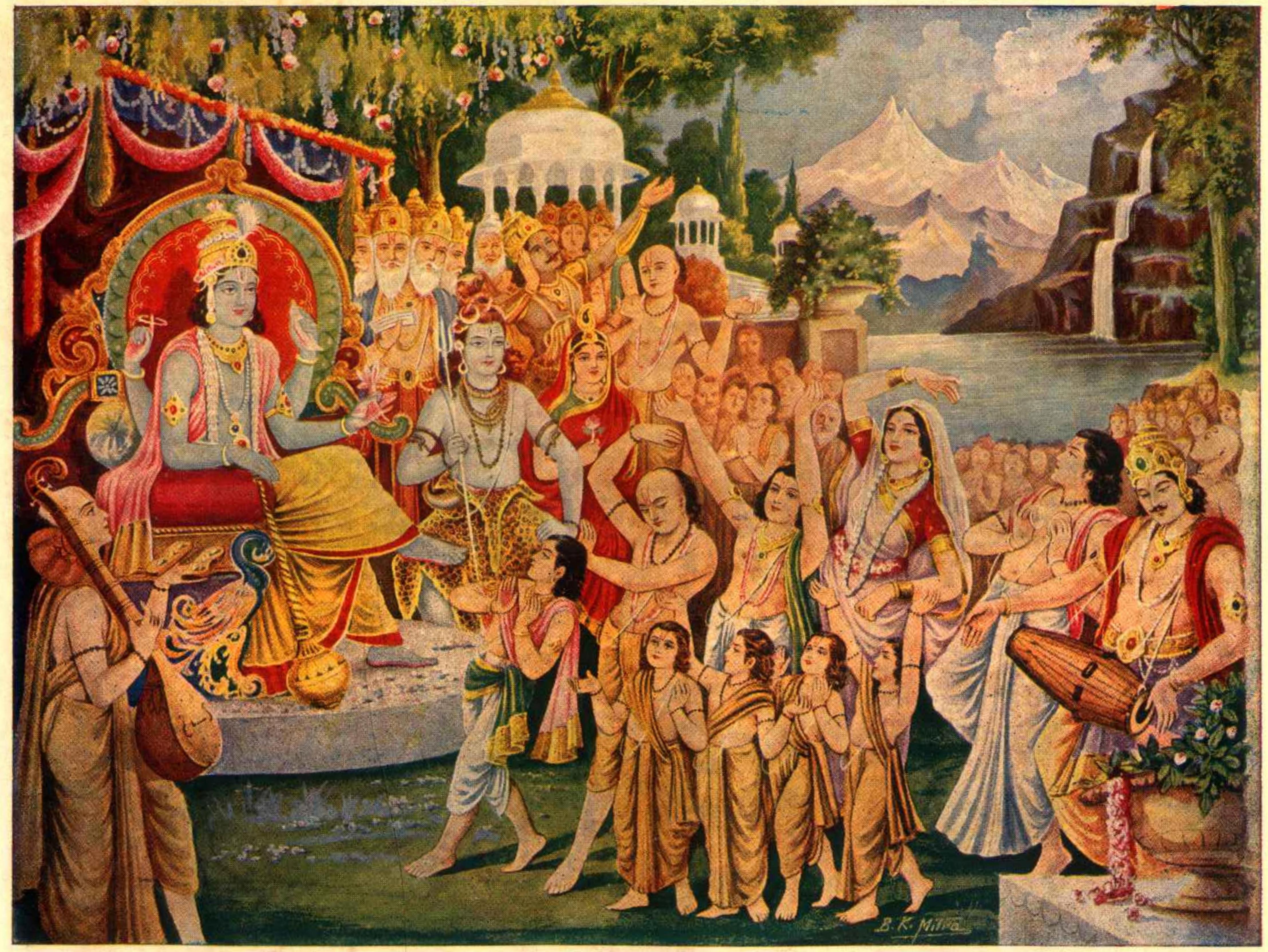|
Kirtans
Kirtana ( sa, कीर्तन; ), also rendered as Kirtan, is a Sanskrit word that means "narrating, reciting, telling, describing" of an idea or story, specifically in Indian religions. It also refers to a genre of religious performance arts, connoting a musical form of narration or shared recitation, particularly of spiritual or religious ideas, native to the Indian subcontinent. With roots in the Vedic ''anukirtana'' tradition, a kirtan is a call-and-response style song or chant, set to music, wherein multiple singers recite or describe a legend, or express loving devotion to a deity, or discuss spiritual ideas. It may include dancing or direct expression of ''bhavas'' (emotive states) by the singer. Many kirtan performances are structured to engage the audience where they either repeat the chant,Sara Brown (2012), ''Every Word Is a Song, Every Step Is a Dance'', PhD Thesis, Florida State University (Advisor: Michael Bakan), pages 25-26, 87-88, 277 or reply to the call of ... [...More Info...] [...Related Items...] OR: [Wikipedia] [Google] [Baidu] |
Harmonium
The pump organ is a type of free-reed organ that generates sound as air flows past a vibrating piece of thin metal in a frame. The piece of metal is called a reed. Specific types of pump organ include the reed organ, harmonium, and melodeon. The idea for the free reed was imported from China through Russia after 1750, and the first Western free-reed instrument was made in 1780 in Denmark. More portable than pipe organs, free-reed organs were widely used in smaller churches and in private homes in the 19th century, but their volume and tonal range were limited. They generally had one or sometimes two manuals, with pedal-boards being rare. The finer pump organs had a wider range of tones, and the cabinets of those intended for churches and affluent homes were often excellent pieces of furniture. Several million free-reed organs and melodeons were made in the US and Canada between the 1850s and the 1920s, some of which were exported. The Cable Company, Estey Organ, and Mason & ... [...More Info...] [...Related Items...] OR: [Wikipedia] [Google] [Baidu] |
Bhajan
Bhajan refers to any devotional song with a religious theme or spiritual ideas, specifically among Indian religions, in any language. The term bhajanam (Sanskrit: भजनम्) means ''reverence'' and originates from the root word ''bhaj'' (Sanskrit: भज्), which means ''to revere'', as in 'Bhaja Govindam' (''Revere Govinda'')''. ''The term bhajana also means ''sharing''. The term 'bhajan' is also commonly used to refer a group event, with one or more lead singers, accompanied with music, and sometimes dancing. Normally, bhajans are accompanied by percussion instruments such as ''tabla'', dholak or a tambourine. Handheld small cymbals (''kartals'') are also commonly used to maintain the beat. A bhajan may be sung in a temple, in a home, under a tree in the open, near a river bank or a place of historic significance.Anna King, John Brockington, ''The Intimate Other: Love Divine in Indic Religions'', Orient Longman 2005, p 179. Having no prescribed form, or set rules, ... [...More Info...] [...Related Items...] OR: [Wikipedia] [Google] [Baidu] |
Mrdanga
The khol is a terracotta two-sided drum used in northern and eastern India for accompaniment with devotional music (''bhakti''). It is also known as a mridanga (< + , ), not to be confused with ''''. It originates from the Indian states of , and . The drum is played with palms and fingers of both hands. Description The khol is regarded as resembling to the ...[...More Info...] [...Related Items...] OR: [Wikipedia] [Google] [Baidu] |
Louis Renou
Louis Renou (; 26 October 1896 – 18 August 1966) was the pre-eminent French Indologist of the twentieth century. Education and Career After passing the ''agrégation'' examination in 1920, Louis Renou taught for a year at the ''lycée'' in Rouen. He then took a sabbatical, read the works of Sanskrit scholars and attended the classes of Antoine Meillet. Henceforth he opted exclusively for the study of Sanskrit. He attended the lectures of Jules Bloch at the ''École des hautes études''. The work he did at this time gave rise to ''Les maîtres de la philologie védique'' (1928). His doctoral thesis, submitted in 1925, was ''La valeur du parfait dans les hymnes védiques''. After a short time at the ''Faculté de lettres'' in Lyon, he moved to ''L'École des hautes études'' and then to the Sorbonne where he succeeded Alfred A. Foucher. In 1946 he was elected to the Académie des Inscriptions. In the following years he undertook three journeys: India in 1948-1949, Yale University i ... [...More Info...] [...Related Items...] OR: [Wikipedia] [Google] [Baidu] |
Yajna
Yajna ( sa, यज्ञ, yajña, translit-std=IAST, sacrifice, devotion, worship, offering) refers in Hinduism to any ritual done in front of a sacred fire, often with mantras.SG Nigal (1986), Axiological Approach to the Vedas, Northern Book, , pages 80–81 Yajna has been a Vedic tradition, described in a layer of Vedic literature called Brahmanas, as well as Yajurveda. The tradition has evolved from offering oblations and libations into sacred fire to symbolic offerings in the presence of sacred fire (Agni). Yajna rituals-related texts have been called the ''Karma-kanda'' (ritual works) portion of the Vedic literature, in contrast to ''Jnana-kanda'' (knowledge) portion contained in the Vedic Upanishads. The proper completion of Yajna-like rituals was the focus of Mimansa school of Hindu philosophy. Yajna have continued to play a central role in a Hindu's rites of passage, such as weddings. Modern major Hindu temple ceremonies, Hindu community celebrations, or monastic ini ... [...More Info...] [...Related Items...] OR: [Wikipedia] [Google] [Baidu] |
Shatapatha Brahmana
The Shatapatha Brahmana ( sa, शतपथब्राह्मणम् , Śatapatha Brāhmaṇam, meaning 'Brāhmaṇa of one hundred paths', abbreviated to 'SB') is a commentary on the Śukla (white) Yajurveda. It is attributed to the Vedic sage Yajnavalkya. Described as the most complete, systematic, and important of the Brahmanas (commentaries on the Vedas), it contains detailed explanations of Vedic sacrificial rituals, symbolism, and mythology. Particularly in its description of sacrificial rituals (including construction of complex fire-altars), the Shatapatha Brahmana (SB) provides scientific knowledge of geometry (e.g. calculations of pi and the root of the Pythagorean theorem) and observational astronomy (e.g. planetary distances and the assertion that the Earth is circular) from the Vedic period. The Shatapatha Brahmana is also considered to be significant in the development of Vaishnavism as the origin of several Puranic legends and avatars of the RigVedic god Vi ... [...More Info...] [...Related Items...] OR: [Wikipedia] [Google] [Baidu] |
Yajna
Yajna ( sa, यज्ञ, yajña, translit-std=IAST, sacrifice, devotion, worship, offering) refers in Hinduism to any ritual done in front of a sacred fire, often with mantras.SG Nigal (1986), Axiological Approach to the Vedas, Northern Book, , pages 80–81 Yajna has been a Vedic tradition, described in a layer of Vedic literature called Brahmanas, as well as Yajurveda. The tradition has evolved from offering oblations and libations into sacred fire to symbolic offerings in the presence of sacred fire (Agni). Yajna rituals-related texts have been called the ''Karma-kanda'' (ritual works) portion of the Vedic literature, in contrast to ''Jnana-kanda'' (knowledge) portion contained in the Vedic Upanishads. The proper completion of Yajna-like rituals was the focus of Mimansa school of Hindu philosophy. Yajna have continued to play a central role in a Hindu's rites of passage, such as weddings. Modern major Hindu temple ceremonies, Hindu community celebrations, or monastic ini ... [...More Info...] [...Related Items...] OR: [Wikipedia] [Google] [Baidu] |
Sikh
Sikhs ( or ; pa, ਸਿੱਖ, ' ) are people who adhere to Sikhism, Sikhism (Sikhi), a Monotheism, monotheistic religion that originated in the late 15th century in the Punjab region of the Indian subcontinent, based on the revelation of Guru Nanak. The term ''Sikh'' has its origin in the word ' (), meaning 'disciple' or 'student'. Male Sikhs generally have ''Singh'' ('lion'/'tiger') as their last name, though not all Singhs are necessarily Sikhs; likewise, female Sikhs have ''Kaur'' ('princess') as their last name. These unique last names were given by the Gurus to allow Sikhs to stand out and also as an act of defiance to India's caste system, which the Gurus were always against. Sikhs strongly believe in the idea of "Sarbat Da Bhala" - "Welfare of all" and are often seen on the frontline to provide humanitarian aid across the world. Sikhs who have undergone the ''Amrit Sanchar'' ('baptism by Khanda (Sikh symbol), Khanda'), an initiation ceremony, are from the day of thei ... [...More Info...] [...Related Items...] OR: [Wikipedia] [Google] [Baidu] |
Samhita
Saṃhitā literally means "put together, joined, union", a "collection", and "a methodically, rule-based combination of text or verses". Monier-Williams' Sanskrit-English Dictionary, Oxford University Press, page 1123 ''Saṃhitā'' also refers to the most ancient layer of text in the s, consisting of s, hymns, prayers, and s.Lochtefeld, James G. "Samhita" in The I ... [...More Info...] [...Related Items...] OR: [Wikipedia] [Google] [Baidu] |
Sant (religion)
A ''sant'' ( sa, सन्त्; IAST: ; ) is a human being revered as a "truth-exemplar" for their abnormal of "self, truth, ndreality" in Indic religions, particularly Hinduism, Jainism, Sikhism, and Buddhism. In Sikhism it is used to describe a being who has attained spiritual enlightenment and divine knowledge and power through union with God. Etymology "''Sant''" is sometimes translated as " saint", but this is a false cognate (there is no etymological commonality) as "''sant''" is derived from the Sanskrit root ''sat'', which can mean "truth, reality, essence", while "saint" is derived from the Latin word , which means "holy, sacred",William Pinch (1996), Peasants and Monks in British India, University of California Press, , page 181 footnote 3 derived from Indo-European root ''sak-'', "to sanctify". Schomer and McLeod explain ''sant'' as preceptor of ''Sat'' or "truth, reality", in the sense of "'one who knows the truth' or 'one who has experienced Ultimate Reality', ... [...More Info...] [...Related Items...] OR: [Wikipedia] [Google] [Baidu] |
Brahmanas
The Brahmanas (; Sanskrit: , ''Brāhmaṇam'') are Vedic śruti works attached to the Samhitas (hymns and mantras) of the Rig, Sama, Yajur, and Atharva Vedas. They are a secondary layer or classification of Sanskrit texts embedded within each Veda, which explain and instruct on the performance of Vedic rituals (in which the related Samhitas are recited). In addition to explaining the symbolism and meaning of the Samhitas, Brahmana literature also expounds scientific knowledge of the Vedic Period, including observational astronomy and, particularly in relation to altar construction, geometry. Divergent in nature, some Brahmanas also contain mystical and philosophical material that constitutes Aranyakas and Upanishads. Each Veda has one or more of its own Brahmanas, and each Brahmana is generally associated with a particular Shakha or Vedic school. Less than twenty Brahmanas are currently extant, as most have been lost or destroyed. Dating of the final codification of the ''B ... [...More Info...] [...Related Items...] OR: [Wikipedia] [Google] [Baidu] |








